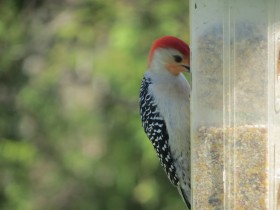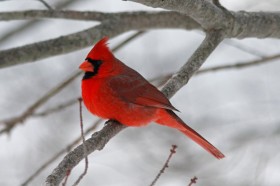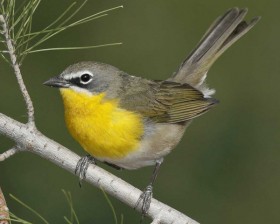And then there are the special moments that bring joy and excitement to a day that might desperately need a lift. This often occurs in late winter and early spring and that’s the time we need a lift the most. Why late in the year, for several reasons. Some birds shift feeders because some people go south or discontinue to put food out. Some are starting to migrate with the changing season and happen by your feeder, some are falling in love and looking around for that special someone. Birds are often drawn to the activities of other birds so a busy well stocked feeder helps to bring in new visitors. Over the years I have seen one female Baltimore Oriole, one Peregrine falcon (with a leg band attached), and an almost albino male Evening Grosbeak. The Grosbeak had the yellow and white colors intact but no black. What a sight.
Some other special birds you might see at the feeder are;
Snow Buntings can be seen all winter in flocks of a dozen or more in field locations; especially on highway 7 in North Lochaber in front of Terry Taylors farm. This picture was taken at the base of a Lochaber bird feeder.
Fox sparrows are sometimes seen during their brief northward migration for only a week around the 1st week of april. A real sign of spring.
Its a treat to see a sharp-shinned Hawk at the feeder even though its about to become tragic. They swoop in very fast and in a manner as to be undetected by small birds until too late. They are a small woods hawk. Their tails are long and well adapted to flying very fast through heavy cover after their prey. They also chase prey on the ground on foot. If your feeder is very busy and then nothing at all; check out nearby bushes and see if small birds like chick-a-dees are being very quiet and still in the very center of the bushes. Then look where they are looking and you will probably see a sharp-shinned hawk.
I get a Rose-brested Grosbeak maybe every 3rd or 4th year. May people have never seen one at all. For the most part they are found near rivers and streams an are most commonly seen by canoeists and kayakers.
The Pine Warbler can be mistaken for a female Goldfinch but notice the greenish back. Also note that when you have several Goldfinches on the feeder at the same time, and you usually do, the males are very much different and the males and females of a species usually travel together. The Pine Warbler is more likely to be alone.
The Palm Warbler is a rarity on feeders but great to see from time to time.
Last year there were several sightings of Red-bellied woodpeckers in this area. Very rare and beautiful. Their call is very distinctive; like a “trill”, and once you hear it you can ID this bird from a distance. Very common in Florida.
The White-breasted Nuthatch is much rarer in Lochaber than the Rose-breasted. It is also larger. It is invariably seen pointing downward on the feeder.
It would take a hard hearted person not to stop and watch this bird. Every winter they show up in very small single sightings; usually in towns with lots of feeders. They are so special the word gets around quickly and people drop by for a look. The are becoming quite common in the southern parts of Nova Scotia; no doubt due to the warming trend.
It was a special day when Harriet MacMillan spotted this bird on a feeder during the Christmas bird count a few years ago. They are rare and a great addition to a bird list.
Of anyone sees a rare bird on or near their feeders in the Lochaber area I would appreciate a comment. Maybe next year the list will be bigger.









